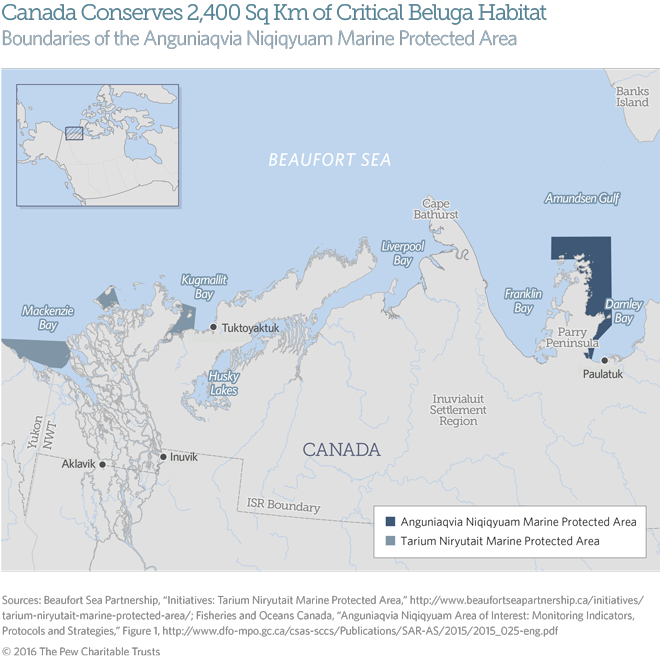Pew Applauds New Marine Protected Area in Canada’s Arctic
Action creates a network that safeguards belugas’ summer habitat
WASHINGTON—The Pew Charitable Trusts commends Fisheries and Oceans Canada and the government of the Northwest Territories for creation of the Anguniaqvia Niqiqyuam Marine Protected Area, a 2,400-square-kilometre (926-square-mile) region in Canada’s Beaufort Sea that provides critical habitat for marine mammals and fish. The announcement was made today in Ottawa.
Fisheries and Oceans Canada worked closely over the past several years with leaders of the Inuvialuit Settlement Region to ensure protection for the waters of Darnley Bay near the community of Paulatuk. The marine ecosystem is home to bowhead and beluga whales, ringed and bearded seals, and fish that local communities rely on for cultural and economic sustenance.
“This is a big step toward advancing marine conservation in the Arctic and ensuring a healthy and abundant ocean for the Inuvialuit of today and tomorrow,” said Scott Highleyman, international director of Pew’s Arctic conservation project.
The new regulations, which take effect immediately, prohibit “any activity that disturbs, damages, destroys in the ANMPA [Anguniaqvia Niqiqyuam Marine Protected Area] or removes from the ANMPA any living marine organism or any part of its habitat.” This language bans oil and gas exploration, and commercial fishing in these waters. Inuvialuit fishing is maintained in accordance with the Inuvialuit Final Agreement and territorial regulations. The new area, together with the existing Tarium Niryutait Marine Protected Area in the nearby Mackenzie River estuary of the Beaufort Sea, will safeguard key summering habitat for about 28 percent, or close to 40,000, of the world’s belugas.
During the planning process, federal officials took the important step of using Inuvialuit traditional knowledge to guide the development of conservation objectives, boundary delineation, and establishment of key monitoring parameters.
“This is Canada’s first action toward realizing a national commitment to protect 10 percent of its domestic waters, including the Arctic, by 2020,” said Chris Debicki, spokesman for Oceans North Canada, a project led by Pew in partnership with Ducks Unlimited Canada.
For the past three years, Oceans North Canada has collaborated with the Paulatuk Hunters and Trappers Committee, the Inuvialuit Game Council, and the Fisheries Joint Management Committee to support community-driven ecosystem studies in Darnley Bay. The research included passive acoustic monitoring of marine mammals and data collection by onshore observers and drones to track beluga and bowhead whales, seals, fish, and waterfowl with the goal of enhancing the scientific understanding of how marine wildlife use the area.
###
The Pew Charitable Trusts is driven by the power of knowledge to solve today’s most challenging problems.
Oceans North Canada promotes science and community-based conservation of Canada’s Arctic Ocean and is a project led by Pew in partnership with Ducks Unlimited Canada. Learn more at pewtrusts.org/oceans-north-canada.












